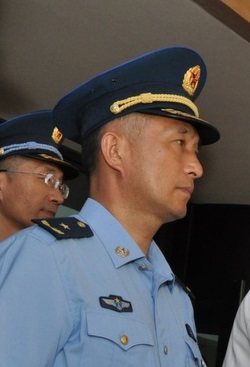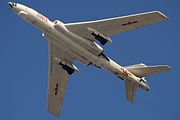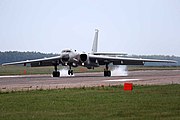
The People's Liberation Army Air Force, also referred to as the Chinese Air Force (中国空军) or the People's Air Force (人民空军), is an aerial service branch of the People's Liberation Army, the military force of the People's Republic of China. The PLAAF was officially established on 11 November 1949 and it is composed of five branches: aviation, ground-based air defense, radar, Airborne Corps and other support elements.

The Xi'an H-6 is a twin-engine jet bomber of the Chinese People's Liberation Army Air Force (PLAAF). The H-6 is a license-built version of the Soviet Tupolev Tu-16 and remains the primary bomber aircraft of the People's Republic of China.
The 15th Fighter Aviation Division is a formation of the Chinese People's Liberation Army Air Force.
The 1st Fighter Brigade, sometimes called 1st Air Brigade, previously 1st Fighter Division, is a fighter aircraft unit of the Chinese People's Liberation Army Air Force (PLAAF) based at Xianyang in Shaanxi province. Part of the Northern Theater Command Air Force, the brigade was originally established as the first division level formation of the PLAAF, established 19 June 1950. In the Korean War the unit shot down 92 airplanes. It was the first in PLAAF history to fight in air combat, provide close air support, perform night bombing operations and more. It is also the only air brigade of the People's Liberation Army Air Force to participate in five Chinese national day parades. The unit's MUCD is 93056.
Luhe-Ma'an Air Base, also known as Nanjing Luhe Airport or Nanjing Air Base, is a military airport that has been home to the Nanjing Air Base of the People's Liberation Army Air Force since 2015, replacing the old Dajiaochang Airport. It is located in suburban Luhe District across the Yangtze River from the center of Nanjing, capital of China's Jiangsu Province.
Yu Zhongfu is a general of the People's Liberation Army Air Force (PLAAF) of China. Having served in the PLAAF for more than 40 years, he was appointed Political Commissar of the PLAAF in July 2015. He was replaced by general Guo Puxiao in January 2022.

Ding Laihang is a general of the Chinese People's Liberation Army Air Force (PLAAF) who served as Commander of People's Liberation Army Air Force from 2017 to 2021. Prior to that, he was commander of the Shenyang Military Region Air Force and then commander of the Northern Theater Command Air Force.

The Eastern Theater Command is one of the five theater commands of the People's Liberation Army (PLA), founded 1 February 2016. It replaced the Nanjing Military Region. The command is headquartered in Nanjing.
43rd Airborne Division is one of three mobile assets of 15th Airborne Corps of the People's Liberation Army Air Force (PLAAF) of People's Republic of China, and a Rapid Reaction, Level One unit of PLAAF.

The People's Liberation Army Air Force Airborne Corps is an airborne corps under direct command of the People's Liberation Army Air Force (PLAAF). It was reorganized and renamed from the 15th Airborne Corps in May 2017 and now comprises six airborne brigades and a special operations brigade. The PLAAF Airborne Corps is China's primary strategic airborne unit and part of the newly formed rapid reaction units (RRUs) of the Chinese military which is primarily designated for airborne and special operation missions. Its role is similar to that of the U.S. Army's XVIII Airborne Corps, the British Army's Parachute Regiment and the Russian Airborne Forces.
The 5th Aviation Division (People's Republic of China) (中国人民解放军空军航空兵第五师, Unit 94590) is the first attack aircraft division of the People's Liberation Army Air Force, and a unit of the Central Military Commission's strategic reserve, founded on December 5, 1950.

WZ-8, is an unmanned aerial vehicle produced by Aviation Industry Corporation of China (AVIC). Introduced during China's 70th anniversary military parade, the drone is intended to conduct strategic aerial reconnaissance across southeast Asia, particularly Taiwan, South Korea and Japan. Its reconnaissance capabilities reportedly include electro-optical imaging, synthetic-aperture radar, and other sensors. Some have suggested the drone will be weaponized to provide strategic anti-access/area denial capabilities. The drone cannot take off under its own power, instead it is air-launched from a Xi'an H-6M mothership once the H-6 reaches a prescribed speed and altitude.

The 8th Bomber Division or 8th Air Division of the People's Liberation Army Air Force (PLAAF) is an air formation of the People's Republic of China (PRC). Today, the 8th Bomber Division is assigned to the Southern Theater Command and operates Xian H-6 bombers. The 8th Bomber Division, the first and longest-serving bomber unit in the PRC, has been deployed in the 1950–1953 Korean War, 1958 Second Taiwan Strait Crisis, 1959 Tibetan uprising, and today conducts deterrence patrols in the South China Sea.

The 36th Bomber Division or 36th Air Division of the People's Liberation Army Air Force (PLAAF) is an air formation of the People's Republic of China (PRC). The 36th Bomber Division is one of only three bomber divisions in the PLAAF and is presently assigned to the Central Theater Command Air Force.

The 66th Brigade, also known as the 66th OPFOR Brigade or 66th Blue Brigade is an air formation of the People's Republic of China (PRC). The 66th Brigade serves as an aggressor unit designed to simulate adversarial air combat forces in training. Appearing to be the only such opposing force (OPFOR) unit of the Chinese People's Liberation Army Air Force (PLAAF), the unit can be compared to the aggressor squadrons of the United States and Canada. The unit is garrisoned at Cangxian Air Base in Hebei Province and reports to the Air Force Flight Test and Evaluation Center, itself subordinate to the Air Force Flight Test and Training Base (FTTB).
The 8th Fighter Brigade is a fighter aircraft unit of the People's Liberation Army Air Force. Previously the 8th Fighter Regiment of the 3rd Air Division, the unit serves as part of the Eastern Theater Command Air Force, responsible for conflict in the East China Sea and Taiwan Strait.

The 29th Fighter Division, also called the 29th Air Division was a fighter division of the Chinese People's Liberation Army Air Force (PLAAF) based in Quzhou, Zhejiang province. Headquartered at Quzhou Air Base, the unit was under the control of the Eastern Theater Command Air Force. The 29th operated Sukhoi Su-30MKK, Chengdu J-7H, and Shenyang J-8B aircraft in support of air operations in the East China Sea and Taiwan Strait. As of 2019, the division commander was Xu Xueqiang. Since the near complete abolition of divisions from the PLA command structure around 2017, the previously subordinate 85th and 87th Fighter Regiments of the 29th FD survived as the 85th and 78th Fighter Brigades, respectively.

The 9th Fighter Brigade, sometimes called the 9th Air Brigade is a fighter brigade of the Chinese People's Liberation Army Air Force (PLAAF) based at Wuhu Air Base in Wuhu, Anhui province. Called "the elite of all elite divisions in the PLAAF," the unit flies the Chengdu J-20 stealth fighter as the premier fighter aviation unit in the Eastern Theater Command Air Force. Until 2017, the 9th Brigade was known as the 1st Flying Brigade of the 9th Regiment of the 3rd Fighter Air Division, at which time the division was abolished and the surviving 7th, 8th, and 9th regiments beneath it were reorganized into independent fighter brigades. Also known as the Wang Hai Brigade, the unit and its ancestors were each the first PLAAF unit to operationally employ the Chengdu J-7, Sukhoi Su-27, Sukhoi Su-30MKK, and Chengdu J-20. The brigade's MUCD is not publicly known.

The Harbin Flight Academy is an aviation training academy in the People's Republic of China reporting directly to the People's Liberation Army Air Force (PLAAF) headquarters. One of three flight academies in the PLAAF, Harbin Flight Academy is located in Harbin, capital city of Heilongjiang Province and is the only institution to train the Chinese air force bomber pilots.


















